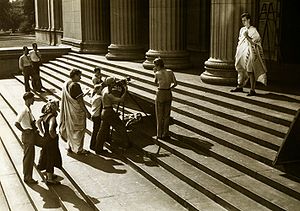"oh" you say, "I don't really do" extra work, or "all I like to do" is extra work. To each their own!
Most productions need extras. Some just need a few, while others need dozens or even hundreds. The more extra work you do, the more people in the industry you will get to know and the more you will be on set. I wanted to cover this topic a little.
1) Why do extra work?
Well, for starters, if your new to the industry, you will get to meet cast and crew, get familiar with how things work and have a lot of fun too. Sometimes you get paid, sometimes you don't. What type of jobs you accept are completely up to you. I know some people who love extra work. Easy breezy, just follow orders and have fun. Usually no lines to memorize, or very few, just do what your told and do it well. I personally love it. I always love to be on set anytime I can. I am not new to the industry, but I love to be around other people who love acting. There is a lot of down time on set as well, where you can get to know your fellow actor or catch up with the ones you haven't seen for a while. As long as camera is not rolling, you can chat and have a great time with this. Seeing the entire production in motion is exciting! I love the action and I love to watch the other actors do their thing. Its like magic in the making!
2) I am an extra, but how do I get upgraded to a speaking role? How do I positively get the attention of the director? Is this even possible?
Many productions for a variety of different reasons, will upgrade an actor from an extra to a principal role, give them a line, or give them a featured extra role, rather than being lost in a crowd of extras. The trick is, how do you get them to pick you? There are a few steps I follow:
a) Basic professionalism: Show up on time, act like a professional, bring required wardrobe, make sure you follow all instructions on your call-sheet or email for the shoot. No complaining, no drama, no excessive cell phone pics, and follow instructions - listen listen listen.
b) Pay attention and smile! When the director or assistant director (AD) is first setting up a scene, many times they will be looking at who else they need. They will be looking at the extras for "clues" on who to pick for a given task. Make sure you know who these people are. The names will be listed on the call sheet and if you pay close enough attention, you will see them. They will see who looks friendly, approachable and professional. I will give you an example. I was on a set last year and the AD was looking at all of us - scanning the extras. Everyone was sitting, looking bored, or chatting with their neighbor. I looked at him straight on with a nice smile, awaiting any instructions. He pointed at me and asked me to come to the ,main set area. He needed a stand-in to rehearse a scene as the lead, because the lead had not shown up yet and the equipment needed to be in the right place and the settings had to be adjusted. We chatted as lights, sound and camera were being adjusted. When the lead showed up, I was placed as a featured extra, directly behind the lead in the scene. I also said thank-you! Very important. This type of thing has happened on numerous occasions, and they will not forget you. It's a small community - you will probably be on set with them again. You want them to remember you!
c) Be able to "go with the flow", be flexible, never assume anything, and have a polite sense of humor. They look for this! They need you to change your wardrobe, memorize a line, re-direct you on the spot. Just go with it and be easy to work with.
Have something to add? Share it! Have fun and I will see you on set!
https://www.facebook.com/DebbieJenningsActor
https://twitter.com/ActressDeb
http://www.imdb.com/name/nm4824944/?ref_=fn_al_nm_1
http://debbiejennings.biz/



